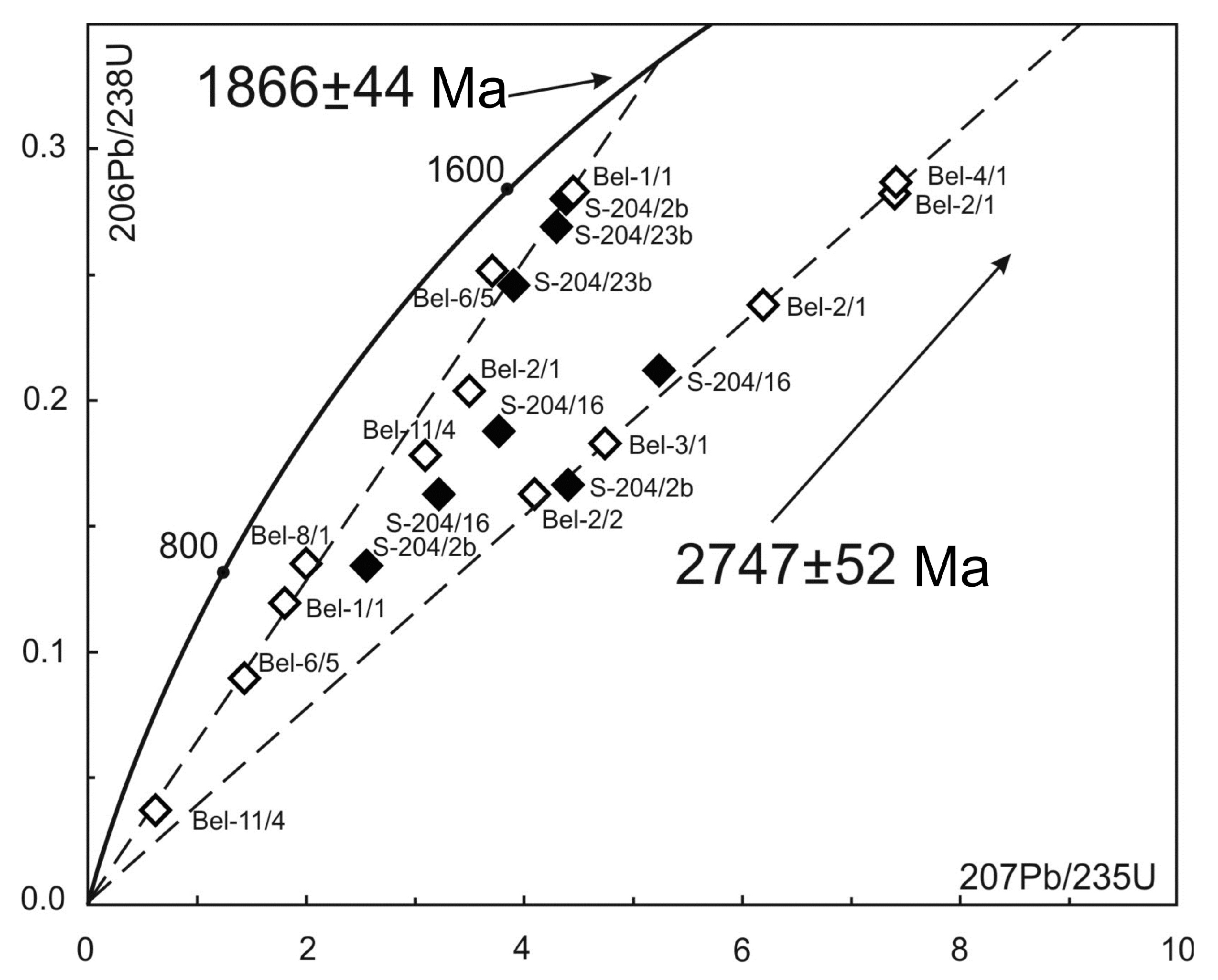Comment on Volodichev et al. Archean Zircons with Omphacite Inclusions from Eclogites of the Belomorian Province, Fennoscandian Shield: The First Finding. Minerals 2021, 11, 1029
Abstract
:Author Contributions
Funding
Conflicts of Interest
References
- Skublov, S.G.; Astaf’ev, B.Y.; Marin, Y.B.; Berezin, A.V.; Mel’nik, A.E.; Presnyakov, S.L. New data on the age of eclogites from the Belomorian Mobile Belt at Gridino settlement area. Dokl. Earth Sci. 2011, 439, 1163–1170. [Google Scholar] [CrossRef]
- Berezin, A.V.; Travin, V.V.; Marin, Y.B.; Skublov, S.G.; Bogomolov, E.S. New U–Pb and Sm–Nd ages and P–T estimates for eclogitization in the Fe-Rich gabbro dyke in Gridino area (Belomorian Mobile Belt). Dokl. Earth Sci. 2012, 444, 760–765. [Google Scholar] [CrossRef]
- Herwartz, D.; Skublov, S.G.; Berezin, A.V.; Mel’nik, A.E. First Lu–Hf Garnet Ages of Eclogites from the Belomorian Mobile Belt (Baltic Shield, Russia). Dokl. Earth Sci. 2012, 443, 377–380. [Google Scholar] [CrossRef]
- Yu, H.L.; Zhang, L.F.; Wei, C.J.; Li, X.L.; Guo, J.H. Age and P–T Conditions of the Gridino eclogite in the Belomorian Province, Russia. J. Metamorph. Geol. 2017, 35, 855–869. [Google Scholar] [CrossRef]
- Yu, H.; Zhang, L.; Lanari, P.; Rubatto, D.; Li, X. Garnet Lu–Hf geochronology and P–T path of the Gridino-type eclogite in the Belomorian Province, Russia. Lithos 2019, 326, 313–326. [Google Scholar] [CrossRef]
- Skublov, S.G.; Berezin, A.V.; Li, X.-H.; Li, Q.-L.; Salimgaraeva, L.I.; Travin, V.V.; Rezvukhin, D.I. Zircons from a Pegmatite Cutting Eclogite (Gridino, Belomorian Mobile Belt): U–Pb–O and Trace Element Constraints on Eclogite Metamorphism and Fluid Activity. Geosciences 2020, 10, 197. [Google Scholar] [CrossRef]
- Melnik, A.E.; Skublov, S.G.; Rubatto, D.; Müller, D.; Li, X.-H.; Li, Q.-L.; Berezin, A.V.; Herwartz, D.; Machevariani, M.M. Garnet and zircon geochronology of the Paleoproterozoic Kuru-Vaara eclogites, northern Belomorian Province, Fennoscandian Shield. Precambrian Res. 2021, 353, 106014. [Google Scholar] [CrossRef]
- Volodichev, O.I.; Maksimov, O.A.; Kuzenko, T.I.; Slabunov, A.I. Archean Zircons with Omphacite Inclusions from Eclogites of the Belomorian Province, Fennoscandian Shield: The First Finding. Minerals 2021, 11, 1029. [Google Scholar] [CrossRef]
- Kaulina, T.V.; Mitrofanov, F.P.; Apanasevich, E.A.; Zhavkov, V.A.; D’yakov, S.N.; Sherstennikova, O.G. U–Pb dating of garnet. In New Data on Geology and Mineral Deposits of the Kola Peninsula; Mitrofanov, F.P., Ed.; Kola Science Centre of the RAS: Apatity, Russia, 2005; pp. 60–64. (In Russian) [Google Scholar]
- DeWolf, C.P.; Zeissler, C.J.; Halliday, A.N.; Mezger, K.; Essene, E.J. The role of inclusions in U–Pb and Sm–Nd garnet geochronology: Stepwise dissolution experiments and trace uranium mapping by fission track analysis. Geochim. Cosmochim. Acta 1996, 60, 121–134. [Google Scholar] [CrossRef]
- Anczkiewicz, R.; Thirlwall, M.F. Improving precision of Sm–Nd garnet dating by H2SO4 leaching: A simple solution to the phosphate inclusion problem. Geol. Soc. Lond. Spec. Publ. 2003, 220, 83–91. [Google Scholar] [CrossRef]
- Morimoto, N. Nomenclature of pyroxenes. Mineral. Petrol. 1988, 39, 55–76. [Google Scholar] [CrossRef]
- Štípská, P.; Schulmann, K.; Kröner, A. Vertical extrusion and middle crustal spreading of omphacite granulite: A model of syn-convergent exhumation (Bohemian Massif, Czech Republic). J. Metamorph. Geol. 2004, 22, 179–198. [Google Scholar] [CrossRef]
- Kryza, R.; Pin, C.; Vielzeuf, D. High-pressure granulites from the Sudetes (south-west Poland): Evidence of crustal subduction and collisional thickening in the Variscan Belt. J. Metamorph. Geol. 1996, 14, 531–546. [Google Scholar] [CrossRef]
- Maksimov, O.A.; Slabunov, A.I.; Balagansky, V.V.; Volodichev, O.I. Archean eclogites from the Belomorian Province (Examples from the Gridino Area). In Proceedings of the Abstract Volume of the 13th International Eclogite Conference, Karelia, Russia, 24–27 June 2019; KRC RAS: Petrozavodsk, Russia, 2019; p. 54. [Google Scholar]
- Oh, C.W.; Liou, J.G. A petrogenetic grid for eclogite and related facies under high-pressure metamorphism. Island Arc 1998, 7, 36–51. [Google Scholar] [CrossRef]
- Rubatto, D. Zircon trace element geochemistry: Partitioning with garnet and the link between U–Pb ages and metamorphism. Chem. Geol. 2002, 184, 123–138. [Google Scholar] [CrossRef]
- Skublov, S.G.; Berezin, A.V.; Berezhnaya, N.G. General Relations in the Trace Element Composition of Zircons from Eclogites with Implications for the Age of Eclogites in the Belomorian Mobile Belt. Petrology 2012, 20, 427–449. [Google Scholar] [CrossRef]
- Perchuk, L.L. The effect of temperature and pressure on the equilibrium of natural iron-magnesium minerals. Int. Geol. Rev. 1969, 11, 875–901. [Google Scholar] [CrossRef]
- Holland, T.J. The reaction albite = jadeite + quartz determined experimentally in the range 600–1200 °C. Am. Mineral. 1980, 65, 129–134. [Google Scholar]
- Menneken, M.; Nemchin, A.A.; Geisler, T.; Pidgeon, R.T.; Wilde, S.A. Hadean diamonds in zircon from Jack Hills, Western Australia. Nature 2007, 448, 917–920. [Google Scholar] [CrossRef] [PubMed]
- Dobrzhinetskaya, L.; Wirth, R.; Green, H. Diamonds in Earthʼs oldest zircons from Jack Hills conglomerate, Australia, are contamination. Earth Planet. Sci. Lett. 2014, 387, 212–218. [Google Scholar] [CrossRef]

Publisher’s Note: MDPI stays neutral with regard to jurisdictional claims in published maps and institutional affiliations. |
© 2022 by the authors. Licensee MDPI, Basel, Switzerland. This article is an open access article distributed under the terms and conditions of the Creative Commons Attribution (CC BY) license (https://creativecommons.org/licenses/by/4.0/).
Share and Cite
Skublov, S.G.; Berezin, A.V.; Salimgaraeva, L.I. Comment on Volodichev et al. Archean Zircons with Omphacite Inclusions from Eclogites of the Belomorian Province, Fennoscandian Shield: The First Finding. Minerals 2021, 11, 1029. Minerals 2022, 12, 141. https://doi.org/10.3390/min12020141
Skublov SG, Berezin AV, Salimgaraeva LI. Comment on Volodichev et al. Archean Zircons with Omphacite Inclusions from Eclogites of the Belomorian Province, Fennoscandian Shield: The First Finding. Minerals 2021, 11, 1029. Minerals. 2022; 12(2):141. https://doi.org/10.3390/min12020141
Chicago/Turabian StyleSkublov, Sergey G., Aleksey V. Berezin, and Laysan I. Salimgaraeva. 2022. "Comment on Volodichev et al. Archean Zircons with Omphacite Inclusions from Eclogites of the Belomorian Province, Fennoscandian Shield: The First Finding. Minerals 2021, 11, 1029" Minerals 12, no. 2: 141. https://doi.org/10.3390/min12020141
APA StyleSkublov, S. G., Berezin, A. V., & Salimgaraeva, L. I. (2022). Comment on Volodichev et al. Archean Zircons with Omphacite Inclusions from Eclogites of the Belomorian Province, Fennoscandian Shield: The First Finding. Minerals 2021, 11, 1029. Minerals, 12(2), 141. https://doi.org/10.3390/min12020141






